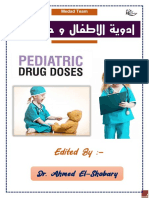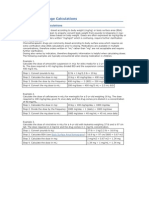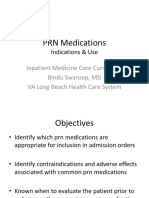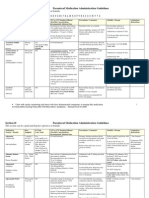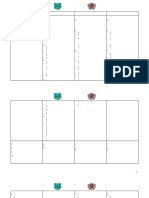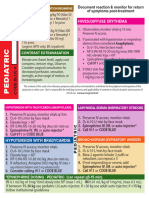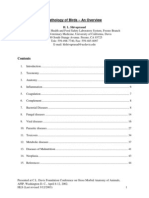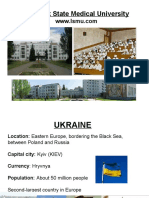Marik Covid Protocol Summary
Marik Covid Protocol Summary
Uploaded by
Internos YopalCopyright:
Available Formats
Marik Covid Protocol Summary
Marik Covid Protocol Summary
Uploaded by
Internos YopalOriginal Title
Copyright
Available Formats
Share this document
Did you find this document useful?
Is this content inappropriate?
Copyright:
Available Formats
Marik Covid Protocol Summary
Marik Covid Protocol Summary
Uploaded by
Internos YopalCopyright:
Available Formats
Critical Care COVID-19 Management Protocol General schema for respiratory support in patients with COVID-19
(updated 6-17-2020) TRY TO AVOID INTUBATION IF POSSIBLE
Low-Flow Nasal Cannula
Prophylaxis
■ Typically set at 1-6 Liters/Min
While there is very limited data (and none specific for COVID-19), the following “cocktail” may
have a role in the prevention/mitigation of COVID-19 disease.
■ Vitamin C 500 mg BID and Quercetin 250-500 mg BID High Flow Nasal Cannula
■ Accept permissive hypoxemia (O2 Saturation > 86%)
■ Zinc 75-100 mg/day
■ Titrate FiO2 based on patient’s saturation
■ Melatonin (slow release): Begin with 0.3mg and increase as tolerated to 2 mg ■ Accept flow rates of 60 to 80 L/min
at night
■ Trial of inhaled Flolan (epoprostenol)
■ Vitamin D3 1000-4000 u/day Attempt proning (cooperative proning)
Deterioration
■
■ Optional: Famotidine 20-40mg/day
Recovery
Mildly Symptomatic patients (at home): Invasive Mechanical Ventilation
■ Vitamin C 500mg BID and Quercetin 250-500 mg BID ■ Target tidal volumes of ~6 cc/kg
■ Zinc 75-100 mg/day ■ Lowest driving pressure and PEEP
■ Melatonin 6-12 mg at night (the optimal dose is unknown) ■ Sedation to avoid self-extubation
Trial of inhaled Flolan
Vitamin D3 2000-4000 u/day
■
■
■ Optional: Ivermectin 150-200ug/kg (single dose)
Prone Positioning
■ Optional: ASA 81/325mg/day ■ Exact indication for prone ventilation is unclear
■ Optional: Famotidine 20-40mg/day ■ Consider in patients with PaO2/FiO2 ratio < 150
In symptomatic patients, monitoring with home pulse oximetry is recommended.
Ambulatory desaturation below 94% should prompt hospital admission
VV-ECMO
Mildly Symptomatic patients (on floor):
■ Indications remain unclear
■ Vitamin C 500 mg PO q 6 hourly and Quercetin 250-500 mg BID (if available) ■ Early discussion with ECMO center or team may be advisable
■ Zinc 75-100 mg/day
■ Melatonin 6-12 mg at night (the optimal dose is unknown)
■ Vitamin D3 2000-4000 u/day ■ Optional: Ivermectin 150-200 ug/kg (single dose)
■ Enoxaparin 60 mg daily ■ N/C 2L /min if required (max 4 L/min; consider early t/f to ICU for escalation of care).
■ Famotidine 40mg daily (20mg in renal impairment) ■ T/f EARLY to the ICU for increasing respiratory signs/symptoms and arterial
■ Methylprednisolone 40 mg q 12 hourly; increase to 80 mg q 12 if poor response desaturations.
■ Optional: Remdesivir 200mg D1 then 100mg daily for 9 days.
continued on next page
Find the latest version at evms.edu/covidcare
Critical Care COVID-19 Management Protocol
(updated 6-17-2020)
Respiratory symptoms (SOB; hypoxia- requiring N/C ≥ 4 L min:
admit to ICU): 15. Escalation of respiratory support; See General Schema for Respiratory
Support in Patients with COVID-19.
Essential Treatment (dampening the STORM)
Salvage Treatments
1. Methylprednisolone 80 mg loading dose then 40 mg q 12 hourly for at
least 7 days and until transferred out of ICU. In patients with poor response,
■ Plasma exchange. Should be considered in patients with progressive
increase to 80 mg q 12 hourly. oxygenation failure despite corticosteroid therapy. Patients may require
up to 5 exchanges.
2. Ascorbic acid (Vitamin C) 3g IV q 6 hourly for at least 7 days and/or until
transferred out of ICU. Note caution with POC glucose testing.
■ High dose corticosteroids; 120 mg methylprednisolone q 6-8 hourly
3. Full anticoagulation: Unless contraindicated we suggest FULL
■ Siltuximab and Tocilizumab (IL-6 inhibitors)
anticoagulation (on admission to the ICU) with enoxaparin, i.e 1 mg kg s/c ■ Convalescent serum; the role and timing of convalescent serum are
q 12 hourly (dose adjust with Cr Cl < 30mls/min). Heparin is suggested with uncertain.
CrCl < 15 ml/min. Treatment of Macrophage Activation Syndrome (MAS)
Note: Early termination of ascorbic acid and corticosteroids will likely result in a ■ A sub-group of patients will develop MAS. A ferritin > 4400 ng/ml
rebound effect.
is considered diagnostic of MAS. Other diagnostic features include
Additional Treatment Components (the Full Monty) increasing AST/ALT and increasing CRP.
4. Melatonin 6-12 mg at night (the optimal dose is unknown). ■ Methylprednisolone 120 mg q 6-8 hourly for at least 3 days, then wean
5. Famotidine 40mg daily (20mg in renal impairment) according to Ferritin, CRP, AST/ALT. Ferritin should decrease by at least
6. Vitamin D 2000-4000 u/day 15% before weaning corticosteroids.
7. Thiamine 200mg IV q 12 hourly Monitoring:
8. Simvastatin 80 mg/day (caution drug-drug interactions) or Atorvastatin ■ On admission: PCT, CRP, IL-6, BNP, Troponins, Ferritin, Neutrophil-
80mg/day Lymphocyte ratio, D-dimer and Mg.
9. Magnesium: 2 g stat IV. Keep Mg between 2.0 and 2.4 mmol/l. Prevent ■ Daily: CRP, Ferritin, D-Dimer and PCT. CRP and Ferritin track disease
hypomagnesemia (which increases the cytokine storm and prolongs Qtc). severity closely (although ferritin tends to lag behind CRP).
10. Optional: Azithromycin 500 mg day 1 then 250 mg for 4 days ■ Thromboelastogram (TEG) in patients with high D-dimer and repeated as
indicated.
11. Optional: Remdesivir, 200 mg IV loading dose D1, followed by 100mg day IV
for 9 days ■ In patients receiving IV vitamin C, the Accu-Chek™ POC glucose monitor
will result in spuriously high blood glucose values. Therefore, a laboratory
12. Broad-spectrum antibiotics if superadded bacterial pneumonia is suspected
glucose is recommended to confirm the blood glucose levels
based on procalcitonin levels and resp. culture (no bronchoscopy).
Post ICU management
13. Maintain EUVOLEMIA
a. Enoxaparin 40-60 mg s/c daily c. Vitamin C 500 mg PO BID
14. Early norepinephrine for hypotension.
b. Methylprednisone 40 mg day, d. Melatonin 3-6 mg at night
then wean slowly
Find the latest version at evms.edu/covidcare Developed and updated by Paul Marik, MD, Chief of Pulmonary and Critical Care Medicine, Eastern Virginia Medical School, Norfolk, VA
You might also like
- Global Oncology Trends 2021-2025Document70 pagesGlobal Oncology Trends 2021-2025Deepak MakkarNo ratings yet
- Pediatric Emergency Pocket GuideDocument2 pagesPediatric Emergency Pocket GuideHongMingNo ratings yet
- Source For Dysphagia TextbookDocument138 pagesSource For Dysphagia TextbookMerry 26100% (2)
- Palliative Care FormularyDocument12 pagesPalliative Care FormularyRicardo FernandesNo ratings yet
- Contrast Reaction Card PediatricDocument2 pagesContrast Reaction Card PediatricJenniffer FlorenciaNo ratings yet
- Case Analysis-The Queen's GambitDocument9 pagesCase Analysis-The Queen's GambitAanchal LohiaNo ratings yet
- Marik Covid Protocol Summary PDFDocument2 pagesMarik Covid Protocol Summary PDFJody VivasNo ratings yet
- Marik Covid Protocol SummaryDocument2 pagesMarik Covid Protocol Summaryshubham rathodNo ratings yet
- Marik Covid Protocol SummaryDocument2 pagesMarik Covid Protocol SummaryelasticemperorNo ratings yet
- Marik Covid Protocol SummaryDocument2 pagesMarik Covid Protocol SummaryCamille05No ratings yet
- Marik Covid Protocol SummaryDocument2 pagesMarik Covid Protocol SummaryCaterina PrepelitaNo ratings yet
- Marik Covid Protocol Summary PDFDocument1 pageMarik Covid Protocol Summary PDFCiuvat Dumitru ValentinNo ratings yet
- CCF IpDocument1 pageCCF IpBryan FjbNo ratings yet
- FLCCC Alliance MATHplus Protocol ENGLISHDocument2 pagesFLCCC Alliance MATHplus Protocol ENGLISHBhanu Kumar100% (1)
- FLCCC Alliance MATHplus Protocol ENGLISHDocument3 pagesFLCCC Alliance MATHplus Protocol ENGLISHDavid GrayNo ratings yet
- FLCCC Alliance MATHplus Protocol ENGLISHDocument3 pagesFLCCC Alliance MATHplus Protocol ENGLISHJhonn BlackNo ratings yet
- FLCCC Alliance MATHplus Protocol ENGLISHDocument3 pagesFLCCC Alliance MATHplus Protocol ENGLISHfernandohNo ratings yet
- Hospital Treatment Protocol For Covid-19Document4 pagesHospital Treatment Protocol For Covid-19Adrian BoboceaNo ratings yet
- Ambulatory Care MedicineDocument26 pagesAmbulatory Care MedicineJustineValJadeLacabaNo ratings yet
- Drugs in ICUDocument15 pagesDrugs in ICUalaasaidali3No ratings yet
- BNF - 76 - British - National - Formulary - Septem-357-358 PhenobarbtalDocument2 pagesBNF - 76 - British - National - Formulary - Septem-357-358 Phenobarbtalnur aisahNo ratings yet
- COVID MX BsmmuDocument2 pagesCOVID MX BsmmuNuhiat NahreenNo ratings yet
- MX Protocol Book FinalDocument42 pagesMX Protocol Book FinalPawan ChoudharyNo ratings yet
- CMSCN R IgevDocument2 pagesCMSCN R Igevdiana8827534No ratings yet
- 4.2016. Update On PlendilDocument2 pages4.2016. Update On PlendilKhor Chin PooNo ratings yet
- Antibiotics & Analgesics Used in DentistryDocument4 pagesAntibiotics & Analgesics Used in DentistryDominique AbelaNo ratings yet
- 5e. PGD Midwifery Exemptions April 2016Document24 pages5e. PGD Midwifery Exemptions April 2016duygukartalbarutNo ratings yet
- WB Covid Protocol Book 25.09 .20 (1)Document49 pagesWB Covid Protocol Book 25.09 .20 (1)El MirageNo ratings yet
- CNS: Ent:: Review Antibiotic Therapy Daily - Can You: Stop? Switch? Simplify? or State Duration?Document1 pageCNS: Ent:: Review Antibiotic Therapy Daily - Can You: Stop? Switch? Simplify? or State Duration?Fitri RachmadaniNo ratings yet
- Drugs That Require Loading Doses Table FinalDocument1 pageDrugs That Require Loading Doses Table Finalandirio7486No ratings yet
- Medad TeamDocument18 pagesMedad TeamAxmed MaxamedNo ratings yet
- Moonlighting Cheat SheetDocument21 pagesMoonlighting Cheat SheetseconyeartransNo ratings yet
- Antibiotic Hospital ManDocument1 pageAntibiotic Hospital Manarshiya.manasekiNo ratings yet
- Spinal Cord CompressionDocument4 pagesSpinal Cord Compressionian3yeung-2No ratings yet
- Revised COVID 19 SARS-COV2 Treatment Protocol - FinalDocument6 pagesRevised COVID 19 SARS-COV2 Treatment Protocol - FinalupsahuNo ratings yet
- Prevention & Early Outpatient Treatment Protocol For Covid-19Document2 pagesPrevention & Early Outpatient Treatment Protocol For Covid-19mariaNo ratings yet
- Charts and Hearts PDFDocument51 pagesCharts and Hearts PDFBen ScottNo ratings yet
- NICU Drugs GuideDocument49 pagesNICU Drugs GuideArhan100% (1)
- Pediatric Dosage CalculationsDocument5 pagesPediatric Dosage CalculationsLovely Anjenell MacalingaNo ratings yet
- ACLS Algorithms Adult 2010Document12 pagesACLS Algorithms Adult 2010anon_336736395No ratings yet
- Status EPilepticusDocument12 pagesStatus EPilepticusDhanush PNo ratings yet
- Symptom Management Obstruksi BowelDocument5 pagesSymptom Management Obstruksi BowelPutri Mega PetasiNo ratings yet
- VTE-Prophylaxis-Protocol - MOHDocument13 pagesVTE-Prophylaxis-Protocol - MOHreham ONo ratings yet
- Moderately HighLY Protein Bound DrugsDocument10 pagesModerately HighLY Protein Bound DrugsArah MomoNo ratings yet
- PRN Medications: Indications & UseDocument23 pagesPRN Medications: Indications & Usedis_is_me100% (1)
- Atrial Fibrillation TDDocument6 pagesAtrial Fibrillation TDapi-594366475No ratings yet
- Phenytoin Administration GuideDocument2 pagesPhenytoin Administration GuideNoorHaziqZ1926No ratings yet
- Medication Administration PolicyDocument76 pagesMedication Administration PolicyJully GaciasNo ratings yet
- AtropinDocument9 pagesAtropinarfitaaaaNo ratings yet
- Prevention & Early Outpatient Treatment Protocol For Covid-19Document2 pagesPrevention & Early Outpatient Treatment Protocol For Covid-19Arunima MajhiNo ratings yet
- Acls Algorithms 2012Document12 pagesAcls Algorithms 2012kivuNo ratings yet
- Management of Convulsions After The Neonatal Period: DR NgugiDocument22 pagesManagement of Convulsions After The Neonatal Period: DR NgugitheintrovNo ratings yet
- Clinical Asthma Pathway: ED Phase 1a: Initial Assessment - 1st HourDocument2 pagesClinical Asthma Pathway: ED Phase 1a: Initial Assessment - 1st Hourd'Agung NugrohoNo ratings yet
- Moonlighting Cheat Sheet 1Document20 pagesMoonlighting Cheat Sheet 1nicjohnson3024No ratings yet
- Chapter 19Document3 pagesChapter 19claireandrea.dorueloNo ratings yet
- Sample FHP and NCPDocument9 pagesSample FHP and NCPkezyuuuhNo ratings yet
- Contrast Reaction Card PediatricDocument2 pagesContrast Reaction Card PediatricschristinaNo ratings yet
- Critical Care Medications: Anti-Arrhythmics Study Guide: Critical Care EssentialsFrom EverandCritical Care Medications: Anti-Arrhythmics Study Guide: Critical Care EssentialsNo ratings yet
- Top 100 Drugs Pocket Reference Guide (2023 Edition)From EverandTop 100 Drugs Pocket Reference Guide (2023 Edition)No ratings yet
- Critical Care Medications: Vasopressors, Inotropes and Anti-Hypertensives Study Guide: Critical Care EssentialsFrom EverandCritical Care Medications: Vasopressors, Inotropes and Anti-Hypertensives Study Guide: Critical Care EssentialsNo ratings yet
- Avian PathologyDocument48 pagesAvian PathologyEric Cheah100% (1)
- Code Team Training and Assessment Best Practices From The Floor UCM - 486059Document34 pagesCode Team Training and Assessment Best Practices From The Floor UCM - 486059JoaoNo ratings yet
- Activity Intolerance NCPDocument7 pagesActivity Intolerance NCPamitNo ratings yet
- PsyDocument100 pagesPsyEu May KhorNo ratings yet
- Alimentatia Si PancreasulDocument20 pagesAlimentatia Si Pancreasultenzi583No ratings yet
- Exploring The Intersection of HIV, BreastDocument5 pagesExploring The Intersection of HIV, BreastKIU PUBLICATION AND EXTENSIONNo ratings yet
- Complete List of MudrasDocument2 pagesComplete List of MudrasRomanoJovanovicNo ratings yet
- LSMU Presentation April 2010 (Revised Fee)Document17 pagesLSMU Presentation April 2010 (Revised Fee)Javid Ahmed HkNo ratings yet
- 1770 Question BankDocument10 pages1770 Question BankSanal c Sabu100% (1)
- Antiepileptic Drugs ThesisDocument5 pagesAntiepileptic Drugs Thesisfjf8xxz4100% (2)
- Hpathy Hope Heart and Homoeopathy Clinical Experiences in The Pandemic of Covid 19 Case Series Volume 1Document22 pagesHpathy Hope Heart and Homoeopathy Clinical Experiences in The Pandemic of Covid 19 Case Series Volume 1Muhammad ArshadNo ratings yet
- Day Case Anaesthesia: Andrew Green MBBS, Fracgp GP Anaesthetist ANZCA RegistrarDocument50 pagesDay Case Anaesthesia: Andrew Green MBBS, Fracgp GP Anaesthetist ANZCA RegistrarSolape Akin-WilliamsNo ratings yet
- 1 Introduction To First AidDocument20 pages1 Introduction To First AidMarv MarvNo ratings yet
- Template Evidence Tables: 1.1. Evidence Table of Systematic ReviewsDocument10 pagesTemplate Evidence Tables: 1.1. Evidence Table of Systematic ReviewsthelordhaniNo ratings yet
- Label File Course FileDocument20 pagesLabel File Course FileZarina ZainoldinNo ratings yet
- Neonatal Intensive Care Drug ManualDocument203 pagesNeonatal Intensive Care Drug ManualreffadaNo ratings yet
- UGIBDocument34 pagesUGIBChe Ainil ZainodinNo ratings yet
- Skripsi VCO Critikal Riview Destri TesalonikaDocument62 pagesSkripsi VCO Critikal Riview Destri TesalonikaDiki AnuwariNo ratings yet
- TrypanosomiasisDocument39 pagesTrypanosomiasisNani HendrianiNo ratings yet
- En 14683-2005Document1 pageEn 14683-2005vipinbioNo ratings yet
- Hompath EdgeDocument3 pagesHompath Edgedl2cap8560No ratings yet
- Slideshow Medicine 2023 NobelPrizeLessonsDocument11 pagesSlideshow Medicine 2023 NobelPrizeLessonsSkRamizAhmedNo ratings yet
- Cellular AberrationDocument53 pagesCellular AberrationJmBautistaNo ratings yet
- IJANS - A Review of The History, Cultivation, Chemistry, Pharmacology and Adverse Health Effects of KhatDocument18 pagesIJANS - A Review of The History, Cultivation, Chemistry, Pharmacology and Adverse Health Effects of Khatiaset123No ratings yet
- Outline: Course Objectives Plan For The Semester Introduction To PharmacyDocument80 pagesOutline: Course Objectives Plan For The Semester Introduction To PharmacyLan FdzNo ratings yet
- Integrated Case Reflection - GITDocument2 pagesIntegrated Case Reflection - GITamrwaleedkaleemNo ratings yet
- Advances in Telemedicine in OphthalmologyDocument11 pagesAdvances in Telemedicine in OphthalmologyMoneer Ali tahaNo ratings yet






























